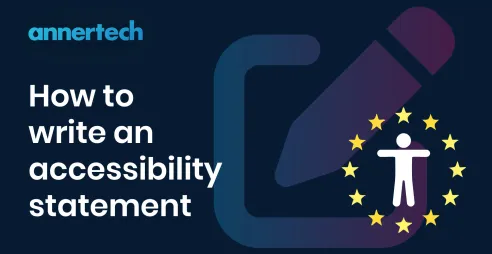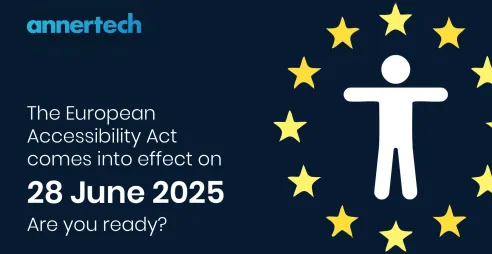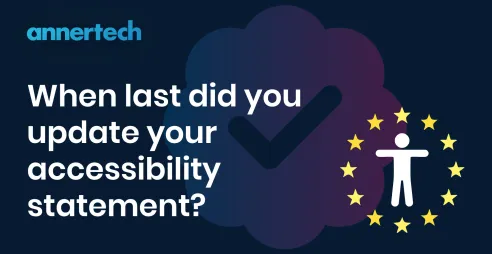8 steps to consistent standards of accessibility

Having trouble getting your accessibility ambitions off the ground? This step-by-step guide will help you ensure that high standards of accessibility are attained on the digital platforms your team creates.
Digital accessibility is the inclusive practice of ensuring that everyone has equal access to information, functionality, and experience on digital platforms.
That means no barriers prevent interaction with, or access to, digital products by people with any type of disability or with traits commonly linked to disabilities.
This is important, because according to the World Health Organization, 1.3 billion people worldwide live with some form of disability.
For example:
- Physical disabilities, such as hearing loss, vision loss, or mobility issues
- Neurodiversity conditions including autism, attention deficit disorder, and dyslexia
- Socioeconomic discrimination which impacts people with disabilities in the US at a rate 2½ higher than people without disabilities.
Common failures
When it comes to accessibility, there are common failures that can easily be solved or fixed. These are:
- Low contrast text
- Focus indicators
- Empty links or buttons
- Missing labels on forms (or not labelled properly)
- Link areas too small
- Poor or broken keyboard navigation
- Non-descriptive text for links
- Improper use of headings.
Although site accessibility audits can be done, and it is possible to fix these issues after the fact, the easiest way to ensure websites are accessible is this: include accessibility in every project, right from the beginning. It is far easier than trying to retrospectively fix things at the end of a project.
Reasons for accessibility regression
These are the main reasons for a decline in the standards of accessibility:
- Lack of awareness of disability barriers or implementation techniques (such as WAI-ARIA, best practices)
- No accessibility requirements in the process, when it comes to:
- Design implementation, style guide or annotations
- Coding standards/methodology
- Code review/QA/UAT
- Time or project pressures
- Zero resource or point of reference to refer to, such as an individual or documentation on the subject
- No buy-in from leadership and clients.
Our 8-step guide
So how do you jumpstart your team’s accessibility know-how in order to raise the standards?
Here is an eight-step guide to raising the bar – and then ensuring those standards are kept high.
1. Have a team or individual(s) to advocate accessibility
The biggest barriers to creating accessible websites are people who don’t care about people who are different.
Appointing an accessibility advocate, whether it’s a passionate internal person or someone from the outside, is a great way to start promoting accessibility within a team. However, advocating for accessibility will only work if there is complete buy-in and support from leadership.

Tom Bamford, who is Annertech's accessibility advocate, gives a presentation at DrupalCon Prague 2022.
This team or person will ideally support accessibility at every stage of every project, will promote accessibility within the team, and help empower everyone on the team to learn and get better when it comes to accessibility.
2. Discover existing understanding and knowledge
Poll your team members in order to assess the existing accessibility skills in the organisation and then validate assumptions against the guidelines. There are many common misconceptions with accessibility, and people are often surprised when those assumptions are unfounded.
3. Build awareness
One of the first places to start building awareness is by cultivating empathy and awareness. This step isn’t about penalising - it’s about understanding where people are coming from, and giving them the empathy to relate to the barriers faced by others every day.
Set up empathy labs (in-person or virtual), create accessibility personas, and encourage people to attend events that are organised around the a11y campaign or Global Accessibility Awareness Day. If difficult experiences are relatable then it’s easier to build empathy.
You can also create awareness through perspective videos or run your own in-house workshops – if possible, get people within your organisation to explain the barriers they face every day; make the difficult experiences relatable.
4. Training
Once awareness has been piqued, the next step is training – to ensure that people know how to make websites accessible.
There are three types of training: Formal training (done through traditional institutions such as universities or colleges, or specialist providers), self-paced learning, and internal discovery and training.
The levels of training also vary, from empathy workshops to learning how to pick up common issues during the discovery phase, recognising issues and barriers, and manual testing and resolving common problems to moving on to complex patterns and in-depth manual testing.
5. Documentation
If information, practices and resources are documented then it not only makes it easy to access but it also serves as a guide for people to refer to if something is unclear.
The documentation that you should have in your accessibility arsenal consists of:
- General Accessibility information
- Curated links to external resources
- Training options
- Examples of accessible code patterns / solutions
- Best practices.
Other information that should be documented is:
- How to fix legacy/inaccessible patterns
- Common problem patterns/modules and replacement solutions
- Who to ask for help.
The documentation can be adjusted and added to as the need arises.
6. Checklists and process adjustments
It is helpful to create checklists for every stage of delivery, from the discovery phase, where expectations of accessibility are discussed, to design (incorporating a style guide and annotations), development, QA and of course the content.
Process adjustments are about how the company or agency changes to incorporate accessibility as part of the process. It includes buy-in from leadership and an internal understanding but it also includes building accessibility into tenders and proposals, and guiding clients.
The best way to approach this is to think about accessibility from the beginning of every project.
It’s not just about internal understanding, and leadership adoption and encouragement. It’s about building accessibility into tenders and proposals, and guiding clients: providing support and services to ensure they comply.
7. Testing and review
When it comes to the accessibility of a project or website it is important to test early and often.
First, define your testing methodologies. These can include:
- Quick checks
- Automated testing
- Manual testing (simplified)
- Manual testing (in-depth).
Second, make sure you have clear objectives and learning resources.
Third, review openly. Code reviews always include accessibility checks. Have discussions on merge or pull requests, and involve other people if there is ambiguity. A great way to learn is by reviewing code as a group.
8. Open communication
Create a dedicated, open space to ask questions about accessibility, and encourage the sharing of solutions and common issues.
You could use a dedicated channel within your team’s communication tool, for example. In this you could regularly post about accessibility updates, tips and tricks, and changes to the WCAG guidelines.
Optimise engagement with short and easy-to-read articles, or provide a summary if articles are too complicated or long. Another great way of communicating is to encourage video-chat reviews and debugging sessions.
If there are unclear topics, impromptu meetings or workshops are great ways to talk through things.
Make accessibility accessible
The most important thing is to make accessibility accessible. And setting high standards from the beginning will inculcate accessibility as part of the company culture, which in turn ensures it isn't an afterthought.
This will not only ensure that high standards of accessibility are attained, but will also ensure that they are maintained.
This blog was written following Tom Bamford’s presentation at DrupalCon Prague, titled "Raising the bar: How to ensure a consistent standard of accessibility". His slides are available to download. The presentation will be available on video shortly and the link will be shared as soon as it becomes available.

Do you need help?
If you have hit a wall when it comes to accessibility, or if you have questions that are difficult to answer, drop us a line. We are happy to help.



